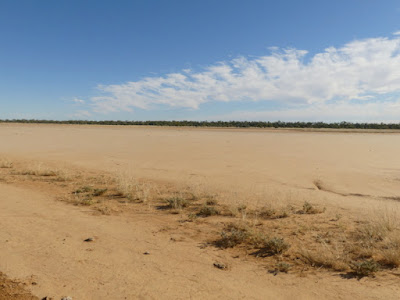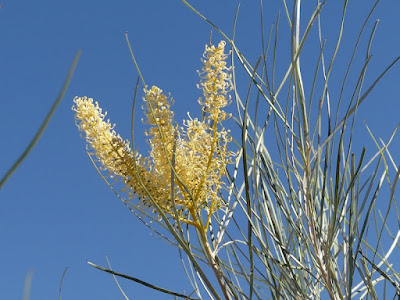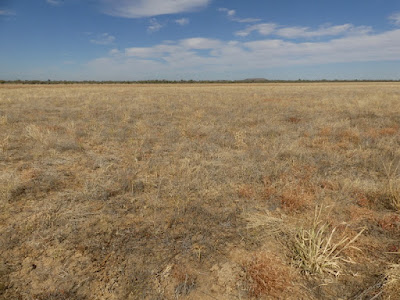As my regular readers may recall, we are recently home from a memorable four weeks in the semi-arid lands of south-western Queensland. This is the first post - but not the last, be warned! - to stem from that trip. I'll be introducing a few state reserves and a couple of other sites over the next few months, albeit mixed in with other topics.
 |
| The end of the red arrow indicates the approximate position of Welford, though I'd not recommend you to use this map to navigate there! |
Little Boomerang Waterhole Campground (the only one in the park) is relatively small and when full is probably a little squishy for our liking, but this was apparently exacerbated by people arriving late and leaving early, some of whom hadn't booked based on the number in the campground on a couple of nights. However for most of the year this wouldn't be an issue and it's a lovely ground, with the sites scattered among Coolabahs Eucalyptus coolabah.
 |
| Our camp among the Coolabahs in the morning at Little Boomerang Waterhole camp; the river is just to the right of this photo. |
Here are three views of the Barcoo from the campground; it really is a beautiful place, with River Red Gums Eucalyptus camaldulensis lining the river. The Barcoo is an unusual river (though perfectly normal in this part of the world!) which flows not to the sea, but inland to the Lake Eyre Basin.
 |
| At dawn... |
 |
| ... a little after sunup... |
 |
| ... and in the evening. |
The River Drive is the shortest and probably least rewarding of the three; ironically the closest it gets to the river is a carpark 200 metres from it, where a rock 'jetty' extends into the water. However of course it's worth doing anyway, because you just never know what might be around the corner!
 |
| Rock 'jetty' in the Barcoo on the River Drive. |
There are no qualms at all about recommending the other two drives however. The Desert Drive is a 22k drive north from the campground, ending at the Jundah-Quilpie Road near the northern border of the park.
 |
| It crosses a clay pan... |
 |
| ... passes a waterhole which isn't on the Barcoo.. |
 |
| Ghost Gum Corymbia dallachiana growing on the spinifex plain. |
Probably the highlight of this drive however was the area of red sand dunes, apparently the eastern-most occurrence of them in this part of the world. One such dune has excellent interpretation (unfortunately not a common offering in most of the parks we visited on this trip) and was a delightful short walk.
 |
| A view from this dune, looking out over the sand plains. |
 |
| Desert Rattlepod Crotolaria eremaea. |
 |
| Sandhill Grevillea Grevillea stenobotrya, one of my favourite grevilleas, which grows and blooms on dunes right across central Australia, from western Queensland to the Indian Ocean. |
 |
| The upright foliage funnels rainwater to the trunk and down to the roots, so that the tree effectively harvests nearly all the rain that falls on it. |
 |
| Mitchell Grass plains along the Mulga Drive. |
 |
| Australian Bustards in tall Mitchell Grass (well yes, I know I did, but you can't really have too many bustards, can you?). |
 |
| Desert Bloodwood Corymbia terminalis growing in the Mitchell Grass. |
At the eastern end of the loop drive there are low stony ridges, with a well-graded easy walk up to Sawyer's Creek Lookout, where there are views out over the mulga-covered plains.
 |
| Across the Mulga to other low ranges at the furthest point of the Mulga Drive. |
 |
| Sawyer's Creek waterhole. The 2021 park management plan foreshadows a 'small bush camp' here that would 'provide a different camping experience to that of the Little Boomerang camp ground', but it is not clear if this is going to happen. |
 |
| Harlequin Emubush Eremophila duttonii. This one grows on sandy soils right across the eastern and central arid zones. |
 |
| Bignonia Emubush Eremophila bignoniiflora, which also has a wide inland distribution but grows by water courses or on floodplains. |
The birds throughout the trip weren't as prolific as I'd expected after the rains, but the country was drying again and despite the previous few photos most of the flowering had passed. Certainly there were few waterbirds despite the presence of good water, and I suspect that many of the nomads had moved further west but I'm only speculating. There's always something though and many of the flocks included young birds.
 |
| Diamond Doves Geopelia cuneata are common, and very attractive, dry country doves, but again this was the first time that we'd seen them on the trip. |
 |
| The Red-backed Kingfisher is the arid land kingfisher Todiramphus pyrrhopygius of Australia, usually seen on any inland trip, but it never seems abundant. |
 |
| Whistling Kites Haliastur sphenurus on the other hand can be found anywhere in Australia where there is water, from the coast to the deserts, especially along rivers. |
 |
| Zebra Finches Taeniopygia castanotis (above and below) are, like the Budgies, arid land El Niño specialists, breeding up to huge numbers in the good years, crashing to survival levels in the others. |
And of course we can't ignore the wonderful Red Kangaroos Osphranter rufus that are emblematic of dry Australia, and for which I'll always pause no matter how often I've seen them. Even just typing this makes me smile to think of them.
If you've read this far you'll enjoy the reality of Welford even more, so put it - and south-west Queensland in general - on your shopping list. I'll be offering more of its parks to tempt you in the coming months, so hope to see you then and thanks for reading.
 |
| The start of a day on the plains of Welford, with the moon still bright before sunrise... |
 |
| ... and its ending with the afterglow of sunset through the Coolabahs of the campground. |
Should you wish to be added to it, just send me an email at calochilus51@internode.on.net. You can ask to be removed from the list at any time,or could simply mark an email as Spam, so you won't see future ones.
If you do leave a comment - and I love it when you do - please remember to click the
box below your comment that says 'Email follow-up comments to...[your address]'
so you'll know when I reply - and I always do!









No comments:
Post a Comment